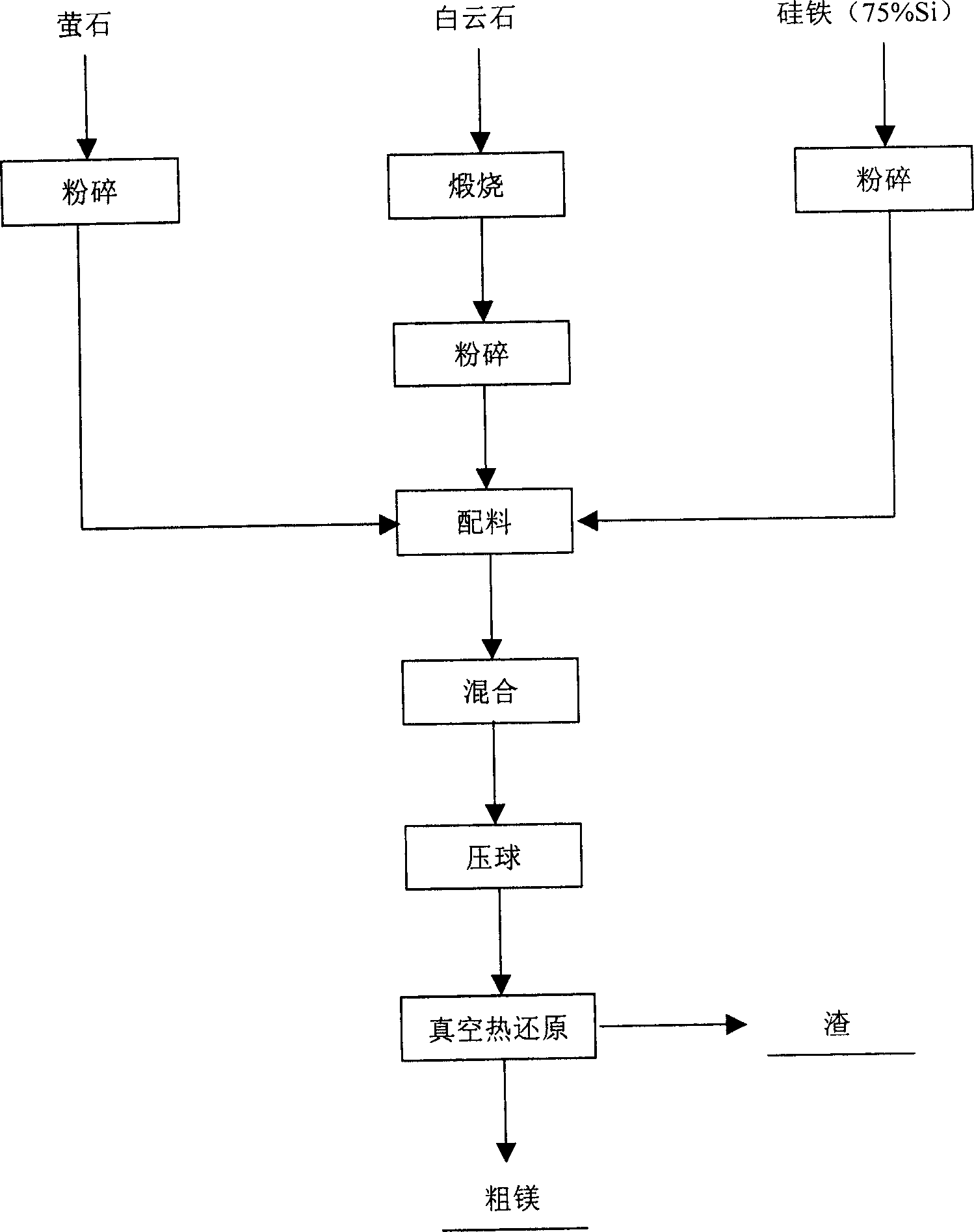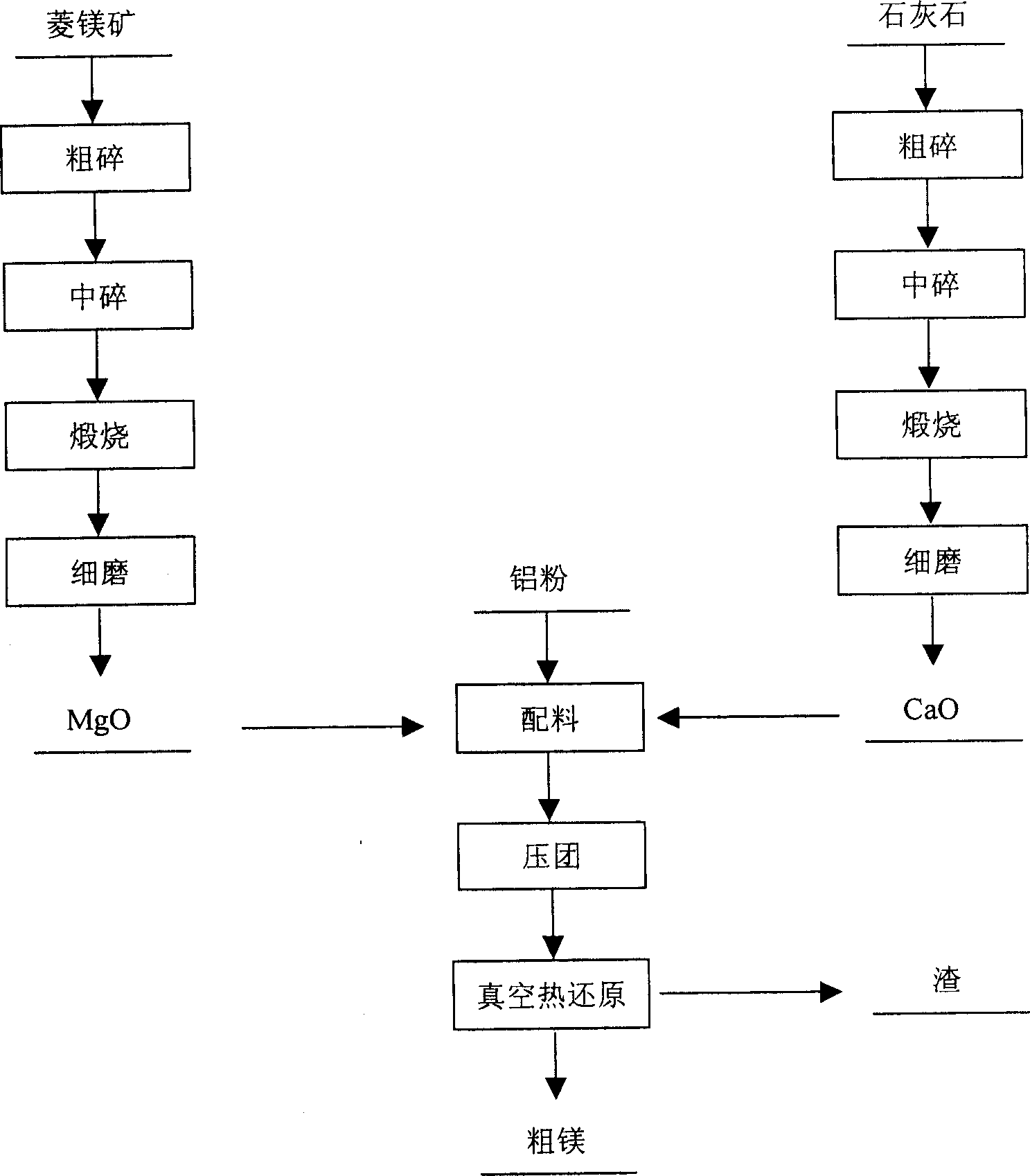Aluminothermic reduction method and technology of giobertite calcination to produce magnesium
A technology for calcining magnesite and magnesite powder, which is applied in the field of extraction of aluminum reduction metals and magnesium, can solve the problems of low slag value, long reduction period, and decreased activity of MgO, and achieve shortened reduction time, which is beneficial to environmental protection, The effect of reducing the amount of processing
- Summary
- Abstract
- Description
- Claims
- Application Information
AI Technical Summary
Problems solved by technology
Method used
Image
Examples
Embodiment 1
[0042] Raw material handling:
[0043] Magnesite (MgCO 3 ) after coarse crushing and medium crushing to a particle size of 0.25mm, calcined at 700°C for 1 hour to make active MgO, and then finely ground and sieved for later use; then limestone (CaCO 3 ) into a powder with a particle size of 0.833 mm, and then calcined at 1100° C. for 1 hour to make CaO powder, and then finely ground and sieved for later use.
[0044] Ingredients Briquette:
[0045] The calcined and sieved fine powder of MgO and CaO and aluminum powder are evenly mixed according to weight percentage: 80:5:15, and then pressed under a press at a pressure of 40 MPa to form agglomerates.
[0046] Reduction of magnesium:
[0047] Put the pressed agglomerate in the reaction tank of Pidgeon method, then put the reaction tank into the heating furnace (reduction furnace), evacuate to 1 Pa, heat to 1050°C, and react for 8 hours to obtain crude magnesium.
Embodiment 2
[0049] Raw material handling:
[0050] Firstly, the magnesite is crushed to a particle size of 0.075mm through primary crushing and secondary crushing, and then calcined at 1000°C for 1 hour to make active MgO, which is finely ground and sieved for later use; then the limestone is crushed by the same process and calcined at 1100°C for 1 hour hour to make CaO powder with a particle size of 0.075mm, and sieve it for later use.
[0051] Ingredients Briquette:
[0052] The calcined and sieved fine powders of MgO and CaO and aluminum powder were uniformly mixed in a weight percentage of 35:15:54, and then pressed under a press at a pressure of 450 MPa to form agglomerates.
[0053] Reduction of magnesium:
[0054] Put the pressed agglomerate in the reaction tank of Pidgeon method, then send the reaction tank into the heating furnace, vacuumize to 13.3 Pa for heating, keep the temperature at 1170°C for 4 hours, and reduce to obtain crude magnesium.
Embodiment 3
[0056] Raw material handling:
[0057] First, the magnesite is crushed to a particle size of 0.15mm through primary crushing and secondary crushing, and then calcined at 900°C for 1 hour to make active MgO, which is then finely ground and sieved for use; then the limestone is crushed to a particle size of 0.25mm by the same process The powder was then calcined at 1150°C for 1 hour to make CaO, which was finely ground and sieved for later use.
[0058] Ingredients Briquette:
[0059] The calcined and sieved MgO, CaO powder and aluminum powder were evenly mixed according to the weight percentage of 65.64:5.07:29.28, and then pressed under a press at a pressure of 300 MPa to form agglomerates.
[0060] Reduction of magnesium:
[0061] Put the pressed agglomerate in the reaction tank of Pidgeon method, then put the reaction tank into the reduction furnace, evacuate to 2 Pa, and react at 1150°C for 6 hours to make crude magnesium.
[0062] In a word, because the present inventio...
PUM
| Property | Measurement | Unit |
|---|---|---|
| particle size | aaaaa | aaaaa |
| particle size | aaaaa | aaaaa |
| particle size | aaaaa | aaaaa |
Abstract
Description
Claims
Application Information
 Login to View More
Login to View More - R&D
- Intellectual Property
- Life Sciences
- Materials
- Tech Scout
- Unparalleled Data Quality
- Higher Quality Content
- 60% Fewer Hallucinations
Browse by: Latest US Patents, China's latest patents, Technical Efficacy Thesaurus, Application Domain, Technology Topic, Popular Technical Reports.
© 2025 PatSnap. All rights reserved.Legal|Privacy policy|Modern Slavery Act Transparency Statement|Sitemap|About US| Contact US: help@patsnap.com



